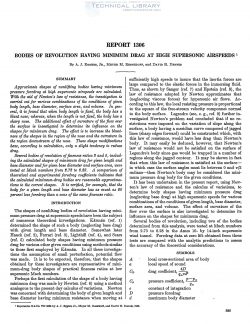naca-report-1306
- Version
- 224 Downloads
- 995.86 KB File Size
- 1 File Count
- November 2, 2016 Create Date
- November 2, 2016 Last Updated
National Advisory Committee for Aeronautics, Report - Bodies of Revolution Having Minimum Drag at High Supersonic Airspeeds

Approximate shapes of nonlifting bodies having minimum
pressure for drag at high supersonic airspeeds are calculated.
With the aid of Newton’s law of resistance, the investigation is
carried out for various combinations of the conditions of given
body length, base diameter, surface area, and volume. In gen-
eral, it is found that when body length is fired, the body has a
blunt nose; whereas, when the length is not fixed, the body has a
sharp nose. The additional effect of curvature of the flow over
the surface is investigated to determine its influence on the
shapes for minimum drag. The eject is to increase the blunt-
ness of the shapes in the region of the nose and the curvature in
the region downstream of the nose. These shape modifications
have, according to calculation, only a slight tendency to reduce
drag.
Several bodies of revolution of fineness ratios 3 and 5, includ-
ing the calculated shapes of minimum drag for given length and
base diameter and for given base diameter and surface area, were
tested at Mach numbers from 2.73 to 6.28. A comparison of
theoretical and experimental foredrag coezficients indicates that
the calculated minimum-drag bodies are reasonable approrim
tions to the correct shapes. It is verified, for example, that the
body for a given length and base diameter has as much as 20
percent less foredrag than a cone of the samefineness ratio.
The shapes of nonljfting bodies of revolution having mini-
mum pressure drag at supersonic speeds have been the subject
of numerous theoretical investigations. Karman (ref. 1)
determined the shape of such a body (neglecting base drag)
with given length and base diameter. Somewhat later
Haack (ref. 2), Ferrari (ref. 3), Lighthill (ref. 4), and Sears
(ref. 5) calculated body shapes having minimum pressure
drag for various other given conditions using methods similar
to those first employed by Karman. In all these investiga-
tions the assumption of small perturbation, potential flow
was made. It is to be expected, therefore, that the shapes
obtained by these investigators are representative‘of mini—
mum—drag body shapes of practical fineness ratios at low
supersonic Mach numbers.
| File | Action |
|---|---|
| naca-report-1306 Bodies of Revolution Having Minimum Drag at High Supersonic Airspeeds.pdf | Download |

Comment On This Post